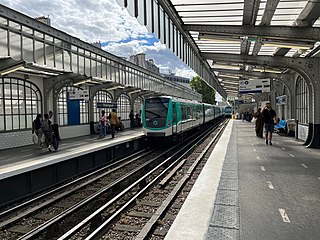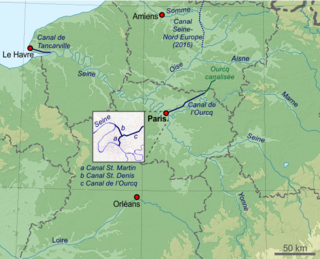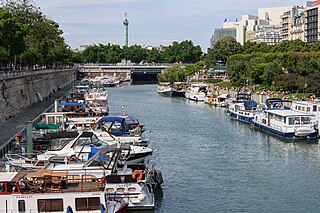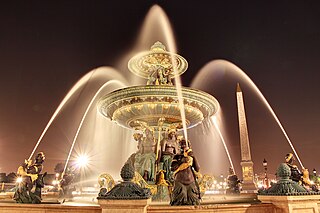Stalingrad is a former name of Volgograd, a city in Russia.

Stalingrad is a Paris Métro station on the border between the 10th arrondissement and 19th arrondissement at the intersection of Lines 2, 5 and 7, located at the Place de la Bataille-de-Stalingrad, which is named after the Battle of Stalingrad.

Laumière is a station of the Paris Métro on line 5 in the 19th arrondissement. It is named after the nearby avenue de Laumière, which was in turn named after Xavier Jean-Marie Clément Vernhet de Laumière (1812-1863), a general killed during the French intervention in Mexico in the 19th century.
Villette or Villettes may refer to:

The Canal Saint-Martin is a 4.6 km long canal in Paris, connecting the Canal de l'Ourcq to the river Seine. Nearly half its length, between the Rue du Faubourg du Temple and the Place de la Bastille, was covered in the mid-19th century to create wide boulevards and public spaces on the surface. The canal is drained and cleaned every 10–15 years, and it is always a source of fascination for Parisians to discover curiosities and even some treasures among the hundreds of tons of discarded objects.

The Second Battle of the Sambre (which included the Second Battle of Guise and the Battle of Thiérache was part of the final European Allied offensives of World War I.

The Parc de la Villette is the third-largest park in Paris, 55.5 hectares in area, located at the northeastern edge of the city in the 19th arrondissement. The park houses one of the largest concentrations of cultural venues in Paris, including the Cité des Sciences et de l'Industrie, three major concert venues, and the prestigious Conservatoire de Paris.

Paris Métro Line 7 is one of sixteen lines of the Paris Métro system. Crossing the capital from its north-eastern to south-eastern sections via a moderately curved path, it links La Courneuve–8 mai 1945 in the north with Mairie d'Ivry and Villejuif–Louis Aragon in the south, while passing through important parts of central Paris.

The Cité des Sciences et de l'Industrie or simply CSI is the biggest science museum in Europe. Located in the Parc de la Villette in Paris, France, it is one of the three dozen French Cultural Centers of Science, Technology and Industry (CCSTI), promoting science and science culture.

The Cité de la Musique, also known as Philharmonie 2, is a group of institutions dedicated to music and situated in the Parc de la Villette, 19th arrondissement of Paris, France. It was designed with the nearby Conservatoire de Paris (CNSMDP) by the architect Christian de Portzamparc and opened in 1995. Part of François Mitterrand's Grands Projets, the Cité de la Musique reinvented La Villette – the former slaughterhouse district.

Paris-Plages is a plan run by the office of the mayor of Paris that creates temporary artificial beaches each summer along the river Seine in the centre of Paris, and, since 2007, along the Bassin de la Villette in the northeast of Paris. Every July and August, roadways on the banks of the Seine are closed off and host various activities, including sandy beaches and palm trees.

The Canal Saint-Denis is a canal in Paris, France that is 6.6 kilometres (4.1 mi) in length. The canal connects the Canal de l'Ourcq, at a point north-northwest of the Bassin de la Villette in the 19th arrondissement, with the suburban municipalities of Saint-Denis and Aubervilliers in the department of Seine-Saint-Denis. There are seven locks along the canal's route, and, near Saint-Denis, the canal discharges into the Seine.

La Villette was a French commune (municipality) in the Seine département lying immediately north-east of Paris. It was one of four communes entirely annexed by the city of Paris in 1859. Its territory is now located in the 19th arrondissement, but a neighborhood has retained its name: the quartier de La Villette and the Parc de la Villette.

The Canal de l'Ourcq is a 108.1 km (67.2 mi) long canal in the Île-de-France region with 10 locks. It was built at a width of 3.20 m (10.5 ft) but was enlarged to 3.7 m (12 ft), which permitted use by more pleasure boats. The canal begins at Port-aux-Perches near the village of Troesnes, where it splits from the channeled river Ourcq, and flows to the Bassin de la Villette, where it joins the Canal Saint-Martin. Paris requires 380,000 cubic metres of water daily for cleaning the sewer system, gutters, and parks. The Canal de l'Ourcq provides about half of the requirement. Since 1983, the waterway has been designated for use by pleasure craft, and its water is designated for non-drinking uses.

The Bassin de l'Arsenal is a boat basin in Paris. It links the Canal Saint-Martin, which begins at the Place de la Bastille, to the Seine, at the Quai de la Rapée. A component of the Réseau des Canaux Parisiens, it forms part of the boundary between the 4th and the 12th arrondissements. It is bordered by the Boulevard Bourdon on the 4th (westerly) side and the Boulevard de la Bastille on the 12th (easterly) side.

The Bassin de la Villette is the largest artificial lake in Paris. It was filled with water on 2 December 1808. Located in the 19th arrondissement of the capital, it links the Canal de l'Ourcq to the Canal Saint-Martin, and it represents one of the elements of the Réseau des Canaux Parisiens, a public-works authority operated by the city. The other components of the network are the Canal de l'Ourcq, the Canal Saint-Denis, the Canal Saint-Martin, and the Bassin de l'Arsenal. Together, these canals and basins extend roughly 130 kilometres (81 mi).

The Fontaines de la Concorde are two monumental fountains located in the Place de la Concorde in the center of Paris. They were designed by Jacques Ignace Hittorff, and completed in 1840 during the reign of King Louis-Philippe. The south fountain commemorates the maritime commerce and industry of France, and the north fountain commemorates navigation and commerce on the rivers of France.

The Grande halle de la Villette, formerly a slaughterhouse and now a cultural center, is located in Paris, France. It is situated on Place de la Fontaine aux Lions within the Parc de la Villette, in the 19th arrondissement. While the Grande Halle is within Paris' main abattoir district, the historical building now serves as a venue for trade fairs, exhibitions, music festivals, and open-air cinema.
This article presents the main landmarks in the city of Paris within administrative limits, divided by its 20 arrondissements. Landmarks located in the suburbs of Paris, outside of its administrative limits, while within the metropolitan area are not included in this article.
















